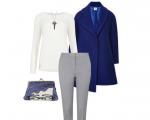How to wear a stiletto heel. Place and time for your beauty
No woman can imagine life without beautiful shoes, especially when it comes to high heel shoes. Heels not only do female leg slender, but also has a smoother and more attractive gait.
No wonder Marilyn Monroe herself considered stilettos an indispensable part of her image. It is to them that the actress owes her seductive gait, and not to long hours of training. To smoothly swing her hips while walking, Marilyn trimmed her heels by an inch.
1. Check your posture.
It's not easy to wear heels. Often such shoes change our silhouette as the center of gravity shifts.
To look beautiful in heels, you need to watch your posture. To do this, take off your shoes and stand against the wall so that your heels, buttocks, shoulder blades and the back of your head are pressed tightly against the support. Hold this position for 1 minute. Then stand on your heels and repeat the same pose. This is how you should walk like wearing shoes flat sole, and on shoes with high heels.
It is important that the head is straight and the chin is raised.
2. Develop posture.
It is very important that your upright posture remains the same throughout the day.
To do this, you can use the following exercise.
Stand in front of a mirror and align your shoulders in one straight line, place your head parallel to your shoulders, and move your shoulder blades back. Stay in this position for 1 minute. Then close your eyes and relax your muscles. After resting, try to restore the pose with eyes closed. Then open your eyes and check in the mirror whether you are standing correctly. Do this exercise several times until your body remembers correct posture. You can train in this way regularly until you can easily restore the pose.
3. Walk correctly.
When you wear high-heeled shoes, you also need to be careful about how you place your feet. The heel, or rather the heel, should touch the ground first, and then the foot. As you step, fully straighten the leg you are using to move. This will keep your gait straight and smooth. Your socks should point outwards, not inwards, otherwise you will look clubbed. The feet should be placed almost in a straight line, and the heels should follow each other.
Hands play an important role in gait. Do not swing your arms too much when walking, otherwise you will create the effect of a windmill.
It is important to remember that not everyone can wear high heels. People suffering from spinal curvature or varicose veins veins, you should wear heels no higher than 5 cm.
Also affects the spine negative impact and flat shoes. Even if you can't wear heels, make sure your shoes are at least a little wedge.
It is also useful to know that our feet are 0.5 cm shorter when we sit. Therefore, when choosing shoes in a store, walk around in the model you like before purchasing.
For proper gait, you need to take into account the size of your shoes. Ideally, the big toe should not touch the toe. However, you should not buy a model one size larger, this will only make your gait heavier.
There is a new hobby in Europe: women go to beauty clinics for collagen injections, which are made into “pads” at the base of the foot. This procedure allows you to wear high heels with virtually no discomfort. And if your feet begin to hurt as a result of wearing high heels for many years, doctors may suggest botox injections in the foot area, blocking nerve impulses and relieving pain for the duration of the drug’s action. But of course it's extreme measures: health is not a sacrifice worth making for the sake of fashion and desire appear more attractive in the eyes of men .
At a safe height
The most “physiological” heel is no more than 3-4 cm. This height preserves the natural position of the foot. If you like to wear shoes on high heels, listen to your body. Swelling, muscle tingling, numbness in fingers, cramps, spider veins, corns, non-healing calluses - all these are signs that it’s time for you to change your couture stilettos to more down-to-earth models. At least for a while to periodically give your legs a rest! Fortunately, comfortable and practical shoes with almost flat soles or small wedges are in fashion today. Another option: shoes with a small platform. It will add a centimeter or two, and even with a 3-4 centimeter heel you will appear taller and your legs slimmer.
Why are high heels dangerous?
Doctors believe that the foot and spine finish developing by the age of 23. Until this age, orthopedists recommend refraining from wearing high heels and stilettos. But even after this age you should be careful with heels. Constantly wearing high heels and narrow shoes often causes deformation of fingers, the impact load on the forefoot also increases, leading to deformation over time. Due to the redistribution of the load on the foot, lovers of heels often develop the so-called heel spur (plantar fasciitis)- overgrowth of the calcaneus. Also due to constant wearing of high heels for a long time, Achilles tendon is deformed and in the future it will be impossible to wear flat-soled shoes. Only surgery can correct the situation.
In addition, the higher the heel, the greater the load on the spine. If you wear high heels (from 8 cm) for a long time, intervertebral hernias, lower back pain, and joint displacement may occur. High heels are harmful and those with scoliosis. And, of course, if my legs started to get very tired after wearing heels - this is a sign that you need to be more attentive to your health.
Kirill Samokhin
surgeon-phlebologist of the Interregional Phlebological Center, teacher of the Department of General Surgery of the Faculty of General Surgery of the 1st Moscow State Medical University named after. I. M. Sechenova
Leg cramps (even rare and mild ones), swelling and a feeling of fatigue that appears in the evening can be the first signs of varicose veins. If you are constantly on your feet during the day, you are at risk for developing varicose veins. And high heels and narrow lasts of dress shoes impede blood circulation and increase the load on the venous system.
How to wear heels?
It is recommended to wear high heels no more than 3-4 hours a day. That's why At work it’s better to have a convenient “shift” .
Give your legs a rest often. Take off your shoes whenever possible and do simple gymnastics for legs– pull the toe towards you, then away from you, rise on tiptoe. Such movements improve blood circulation and relieve leg fatigue.
Orthopedic insole will help make dress shoes more comfortable. You can also use special silicone pads and stickers, which reduce the load on the foot and at the same time prevent the formation of calluses and chafing.
High heels give female silhouette grace and elegance. In breathtaking stilettos, any woman feels like a goddess who walks, barely touching the mortal earth. Men do not remain indifferent, because for them high heels are a sign of a woman’s sexuality. But owning such shoes is half the battle. You need to know how to wear heels.
Why high heels can be dangerous
There are real contraindications to wearing high-heeled shoes. First of all, these are varicose veins. In addition, you should not wear high-heeled shoes if you have problems with the spine, poor posture, flat feet, or problems with overweight. If there are no contraindications, you still shouldn’t abuse wearing high heels. In addition, if you are just starting to get used to such shoes, then you should start with heels no higher than 3-5 cm, and only gradually move on to higher models. The most important condition for any high-heeled shoes is their comfort. No matter how much you like certain shoes, if they cause you discomfort, then it is better to refuse to purchase them.
Women who are new to high-heeled shoes should opt for models with rounded toes that won't pinch their toes. If you buy shoes with open toes, pay attention to the size, as the heel slipping down interferes with normal walking. Do not forget that your feet swell noticeably in the evening, especially if you are forced to constantly wear high-heeled shoes. Subsequently, your fingers may become very swollen, which can lead to pain and calluses. Don't buy shoes that are even a little tight, because wearing such shoes with swollen feet makes walking virtually impossible due to pain and, of course, has a very negative effect on the condition of your feet. If you buy shoes with narrow toes, you need to buy shoes 1 size larger. The same applies to shoes with heels higher than 10 cm.
Secrets of wearing heels Many women are familiar with the trouble associated with bumps on thumbs, which deform and disfigure the shape of the foot. To avoid this, there is little secret, which is successfully used by ballerinas whose legs experience heavy loads. Need to take a small one cotton ball and place it between the first and second finger. Another trick that helps avoid painful deformation of the toes is the use of silicone and gel insoles and special linings in shoes. This method, which allows you to soften the pressure and distribute it correctly, has another version - collagen injections into the fingertips.
But, of course, this is a very radical method. You should wear high heels with caution and practice at home first. If you need to dance, walk a lot and actively, then under no circumstances wear shoes with heels higher than 10 centimeters. There is no need to wear high heels to the office - shoes with 5-centimeter heels also look very feminine and elegant. Narrow stiletto heels look great only with evening dresses. In addition, the thinner the heel, the harder it is to walk on it.
Learn to walk correctly
The most important aspect of wearing high heels is correct gait. It starts with correct posture. Put on your shoes and walk up to the wall, touching it with five points (heels, calves, buttocks, shoulders, back of the head). You must remember this position and maintain it while walking. Remember to straighten your legs and keep your shoulders locked. When stepping on your foot, touch the ground first with your heel and then with the rest of your foot. Try to place your feet in one straight line - this is a model gait that allows you to walk elegantly while swaying your hips. You can use known and effective remedy- walking with a heavy book on your head.
If you feel that walking in heels is still difficult for you, do not force yourself. You can take replacement shoes with you if you need, for example, after work to go to the theater or to an official reception. Beauty and elegance are, of course, good, but health is more expensive in any case. In addition, constant and active wearing of uncomfortable shoes leaves unsightly marks on the feet, the condition of which only gets worse with age. Don't forget about daily and thorough foot care. It is necessary to do a pedicure in a timely manner and get rid of calluses and corns. To do this, it is very useful to take foot baths with herbal poisons (chamomile, oak bark) or with sea salt. If you do not suffer from varicose veins, it will be useful to massage your legs before going to bed. When you go to bed, lubricate your feet with a thick layer of moisturizer.
Heels damage the muscles and joints of the feet. Muscle problems increase the risk of falls and injuries. Long-term consequences no better: deformed feet, back pain, unhealthy gait.
Sammy Margo from the British Royal Society of Physiotherapists sees every day the damage heels can cause: bruises, torn ligaments, calluses and bumps, knee injuries and hip joints, problems with the spine. And fractures, of course, due to the fact that it was not possible to maintain balance.
It is clear that not everyone wears particularly dangerous stilettos and that in general there is a lot of harmful things in the world. But to reduce the damage from heels, help your feet.
1. Choose comfortable heels
Not all heels are necessarily bad for your feet.
For example, if you have a 4-centimeter heel and 1 cm of this height is a platform, then the heel itself turns out to be 3-centimeter. And it's better than 4cm stilettos.
Choose wide ones chunky heels, on which it is easier to maintain balance. IN the right shoes the heel hits the ground and then the weight is transferred smoothly to the balls of the feet.
2. Change your shoes
Heeled shoes shorten and strain calf muscles. And on the other side of the lower leg, the muscles, on the contrary, stretch. The balance in muscle development is disrupted, and this increases the risk of injury.
Therefore, heels do not need to be worn every day. Just like sneakers or ballet shoes with completely flat soles: your feet get used to one position. It is best to alternate shoes so that your feet are not in the same position.
3. Exercise
For example, it is helpful to stand with your toes on the bottom step of the stairs and lower your heels. This will stretch the calf muscles. Hold this position for 10 seconds, then stand on your toes.
It is useful to remember the usual warm-up that we did at school in physical education: walking on your heels, on the outside and on the inside feet.
And when you relax while sitting, roll a water bottle or massage ball with your feet.
Actress and fan healthy image life of Gwyneth Paltrow published a whole complex special exercises, which help to take a break from heels.
Stretching the foot muscles
The first exercise helps against hammertoes, pinched nerves, marching fractures and the formation of bone spurs.
To begin, stretch right hand to your left foot and touch your fingers as if you were going to say hello to your own foot. The thumb will be free, and the other four will be placed between the toes. You need to stay in this position for 30 seconds. Then pull your toes down, stretching top part feet for 5 seconds. Complete 10 reps.
Foot Extensor Stretch

This exercise prevents pain in the lower leg muscles after high loads.
Get on your knees. Place a towel roll under your feet to raise the balls of your feet as high as possible. Slowly lower your hips toward your feet until you feel a stretch in the forefoot and shin. Stay in this position for 30 seconds. Repeat twice.
Peroneal muscle stretch

This exercise combats imbalances in the development of the muscles of the lower leg and foot, and changes in the joints. To perform it you need a belt or rope that does not stretch.
Lie on your back, wrap the strap around the balls of your right foot. Raise the straight right leg, leave the left one extended on the floor. Pull the toes of your right foot towards you and turn your foot inward. Hold the belt with your left hand. Try to stretch your right leg as if you want to touch your left shoulder with your toes. You should feel a stretch in your calves. Hold for 30 seconds.
Repeat the exercise twice for both legs.
Calf stretch

Helps prevent Achilles tendon inflammation, plantar fasciitis and sprains.
Get into a lunge position with your hands on the wall. The left leg is bent, the right leg is extended back. Turn your right foot slightly so that your toe points inward. Do not lift your heels off the floor, lean on right heel. The hips should be parallel to the wall, the knee of the right leg should be straight. Stay in this position for 30 seconds.
Then move your right leg closer to the wall, bending it at the knee. Make sure that the toe still points inward and the heel does not leave the floor. Hold again for 30 seconds.
Do the same exercise on the other leg.
Thumb stretch

Prevents tendon inflammation.
Place your thumb in a corner or ledge of the wall so that it faces up. The rest of your toes and balls of your feet should be flat on the floor. Lean on the wall not only with the tip of your finger, but with most of its surface. The leg should be bent at the knee.
You need to stretch a muscle called the flexor longus muscle. thumb feet. It goes from the toe through the foot and up to the calf. This muscle works when we rise on our toes or stand on our heels, dance or jump.
Shoes with breathtaking stiletto heels can make even the simplest and most modest dress sparkle in a new way, make your legs long and slender, and add self-confidence to a woman.
However, everything comes at a price, and only women know what it takes for their feet to endure walking in high heels for many hours. So that beauty does not require terrible sacrifices and your feet do not get tired of heels, you need to be able to wear such shoes correctly. And now we will discuss how to do this correctly.
First of all, prepare your leg for the load:
If you have to put on heels after a long break, you shouldn’t put them on right away. high heel. Start with a stable heel 5-6 cm high. After walking in it for 2-3 hours a day, give your feet a rest because they are not used to it. After a few days of this training, you will be ready to put on dress shoes.
To prevent your feet from getting tired from heels, train your leg muscles by doing simple exercises: walk a little on your toes, then on your heels. Perform such tasks 5-10 minutes a day. This will strengthen your calf muscles and arches, allowing your legs to cope better with stress.
Take good care of your feet. Daily cool baths and moisturizing of the skin will make it soft and more resistant to inevitable damage.
Try to minimize the time you wear heels as much as possible. If you want to look attractive on the street, change your shoes as soon as you enter the room. If your office dress code requires wearing stilettos, allow yourself to get to work in comfortable soft moccasins or ballet flats.
Wearing high heels special attention pay attention to your posture. The unnatural position of the foot when walking in heels already increases the load on the spine, significantly shifting the center of gravity and unevenly loading the lumbar vertebrae. If at the same time you also slouch or, on the contrary, lean your body too far back, displacement of the cervical or thoracic vertebrae is guaranteed. And this is fraught with migraines, coronary artery disease and sleep problems.
Always try to protect yourself comfortable shoes. Keep a pair of good old shoes in your purse or desk drawer that make you feel as comfortable as slippers. The very idea that you can change your shoes at any moment will make you feel much more confident and calm.
Sedentary work, as well as staying in one position for a long time, causes additional suffering to your legs. A little exercise along the office corridor or simple leg exercises will allow you to improve blood circulation and minimize the damage from high heels.
Excellent prophylactic is considered to be rolling a small ball with rubber spikes between your feet. This exercise stimulates numerous nerve endings located on the sole, and pleasantly massages and refreshes the foot.
When you return home in the evening and take off those beautiful but uncomfortable shoes, try to relieve your tired feet as much as possible:
Allow yourself to lie still in a chair or on the sofa for a few minutes, completely relaxing the muscles of your legs.
Take a relaxing foot bath with aromatic oil lavender or mint. handful sea salt, dissolved in warm water, also perfectly tones tired feet.
Excellent relaxing results when used contrast shower. Just don’t change the water temperature too radically, so as not to cause vasospasm. Alternately pouring cool and warm water over your legs below the knee will allow blood to flow through the vessels faster.
After the procedure, gently pat your skin dry soft towel and give a short massage to improve blood circulation. To do this, gently stroke your feet for several minutes, gradually increasing the pressure. Walk your fingers from your fingertips to your knee, and, after thoroughly massaging your calf muscles, go down.
If your feet are prone to swelling, apply a cooling compress of ice cubes wrapped in thin fabric, or use special ointments and gels for tired legs containing menthol and horse chestnut extract.
When resting or sleeping at night, try to keep your feet above your head. You can simply throw them on the wall, or place a soft, voluminous cushion under them - just to ensure the outflow of blood and lymph from tired limbs.
If you can't do without heels, try as much as possible to minimize the damage caused to your feet. To do this, when choosing the next pair of dress shoes, it is enough to adhere to the following recommendations:
Choose shoes high quality, produced from natural materials. This will allow the skin of your feet to “breathe” and prevent excess sweating and swelling.
A comfortable last will allow you to reduce the load on your foot and allow for a long time do not experience tension when walking.



